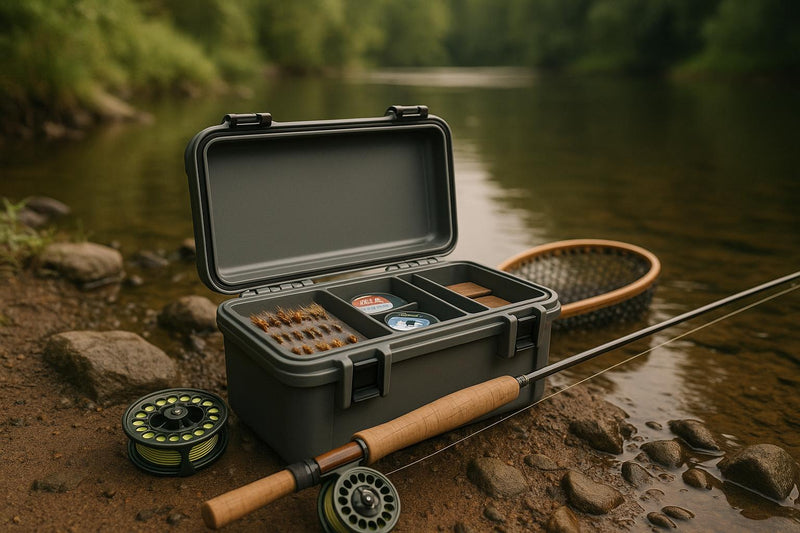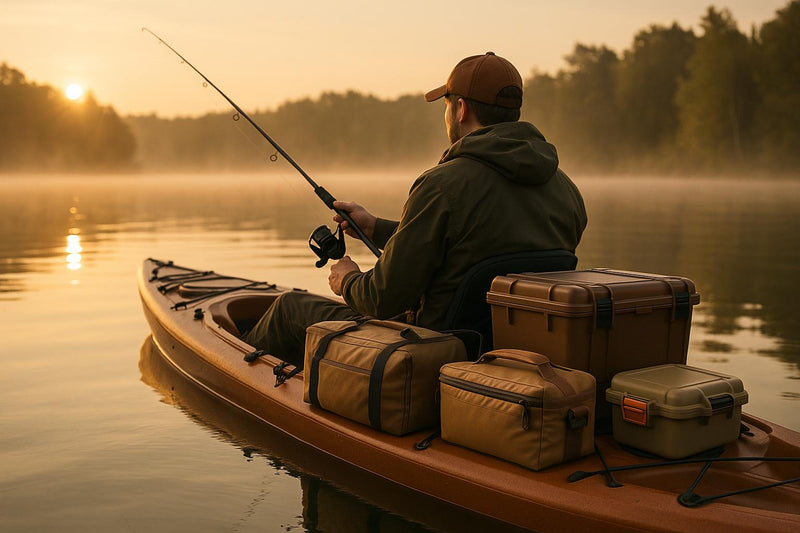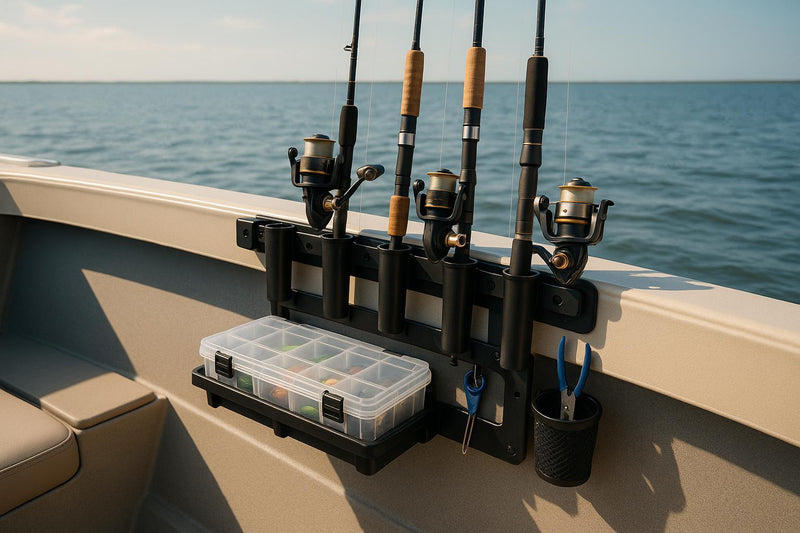Waterproofing fishing shorts keeps you dry, comfortable, and focused while fishing, no matter the conditions. Here’s what you need to know:
- Why It Matters: Staying dry prevents chafing, regulates body temperature, and helps you fish longer without distractions.
- Top Features: Look for quick-dry fabrics like polyester/nylon blends, water-resistant coatings (e.g., DWR), and reinforced stitching for durability.
- How to Waterproof: Use sprays like Nikwax on clean, dry shorts. Focus on seams and high-wear areas, then air-dry or apply heat as directed.
- Testing Effectiveness: Spray water on the fabric - if it beads up, it’s working. Submerge a section to ensure no leaks.
- Maintenance Tips: Wash with technical cleaners, reapply waterproofing after heavy use, and store in a cool, dry place.
Reel Comfort’s fishing shorts combine water resistance, comfort, and durability, making them a reliable choice for anglers. Regular care ensures they perform trip after trip.
Waterproof Technologies and Materials
When it comes to staying dry during your outdoor adventures, understanding waterproof technologies can make all the difference. Knowing how these systems work not only helps you choose better gear but also gives you a deeper appreciation for the engineering behind it.
Common Waterproofing Technologies
Membrane systems are at the heart of waterproof gear. These systems use layers with microscopic pores that are small enough to block water but large enough to let moisture vapor escape, keeping you dry and comfortable.
DWR (Durable Water Repellent) coatings act as the first barrier against moisture. Applied to the outer surface of fabrics, DWR causes water to bead up and roll off rather than soaking into the material. However, over time, DWR coatings can wear down, and when water stops beading, it’s a sign that the coating’s effectiveness has diminished.
Laminated fabrics take waterproofing a step further by bonding waterproof membranes directly to the base fabric. This creates a long-lasting barrier that stands up to challenging conditions like saltwater and prolonged UV exposure.
Key Materials for Waterproof Fishing Shorts
The materials used in waterproof gear are just as critical as the technologies behind them. For fishing shorts, the right combination of materials can mean the difference between staying dry and feeling uncomfortable.
Polyester is a popular choice because it resists UV damage, dries quickly, and maintains its shape even after repeated washes. When treated with waterproof coatings, polyester becomes a lightweight yet durable shield against moisture. Many high-performance fishing shorts are made with polyester blends, offering durability and comfort for long days on the water.
Nylon is another essential material, valued for its excellent tear resistance. It’s often used in areas prone to wear and tear, like pocket edges and seams. Even a small amount of nylon in the fabric blend can significantly boost durability without sacrificing breathability.
PU (Polyurethane) membranes provide an affordable and effective waterproofing solution. These flexible coatings bond tightly to fabric fibers, maintaining their protective qualities even after multiple washes. They also allow moisture vapor to escape, ensuring comfort during active pursuits like fishing.
A thoughtful blend of polyester and nylon creates the ideal balance of durability, flexibility, and quick-drying properties. This combination is especially useful for fishing, where exposure to water is constant. High-quality shorts made from these materials dry quickly after getting wet, keeping you comfortable and ready for action.
Reel Comfort’s fishing shorts are crafted with these advanced materials, ensuring top-tier performance for anglers.
Seam Sealing and Reinforced Stitching
Even the most advanced waterproof fabrics can fall short if seams aren’t properly sealed. Needle holes created during construction can allow water to seep through, but seam sealing solves this problem. Techniques like waterproof tape, liquid sealants, or heat-sealing ensure that seams maintain their waterproof integrity.
Reinforced stitching is another important feature, especially in high-stress areas like pockets, waistbands, and crotches. Double or triple stitching in these zones prevents seam failure and helps maintain the garment’s durability and waterproofing. Quality men’s fishing shorts incorporate reinforced stitching while still providing the flexibility needed for activities like casting and moving around on a boat.
How to Waterproof Fishing Shorts
To keep your fishing shorts performing their best, maintaining their water resistance is essential. Even high-quality gear like Reel Comfort's Fishing Shorts can lose its waterproofing over time due to exposure to salt spray, UV rays, and repeated washing. With the right care, you can restore and even improve their water-repellent properties.
Using Commercial Waterproofing Sprays
Start by thoroughly cleaning your shorts with a performance cleaner to remove dirt, oils, and salt that can block the fabric's breathable membrane. Proper preparation is crucial for effective waterproofing.
For most Durable Water Repellent (DWR) sprays, the shorts should be clean and dry before application. However, some products, like Nikwax, are designed to be applied to damp material for better absorption.
"You want to treat items at room temperature so they can dry completely in a reasonable amount of time. Be sure to wet your item before applying. Nikwax needs to be applied to wet material to effectively be dispersed throughout the material. During the application process, the water-repellent molecule is dispersed throughout the material. As the water (carrier) is removed during the drying process, the molecules link together (polymerize) wrapping the fibers with the water-repellent elastomer. While heat isn't necessary to activate repellency, the item does need to dry completely." – SurfPine (quoting Nikwax customer service)
Before you begin spraying, zip up or button all closures to prevent overspray from reaching the inside of the shorts or pockets. Lay the shorts flat or hang them on a clothesline to ensure even application.
Hold the spray bottle 6–8 inches away and apply a consistent layer over the outer surface. Pay close attention to seams, folds, and fabric flaps, as these areas are more prone to water penetration. After spraying, let the fabric sit briefly, then wipe away any excess with a damp cloth. For areas that experience heavy wear, like the knees or seat, consider adding a second coat for extra protection.
Once you've applied the spray, let the shorts air dry completely, which can take around 24 hours. If the care label allows, you can use heat to enhance the treatment by tumble drying on low for 20–30 minutes, ironing on a warm setting with a protective barrier, or using a hairdryer from a safe distance. Keep in mind that some products, such as Nikwax, don't require heat activation, but ensuring the shorts are thoroughly dry is still crucial.
For your next fishing trip, make sure your gear is ready to handle the elements. Explore Reel Comfort's Men's Fishing Shorts to find premium options built for lasting performance.
Testing Waterproofing Effectiveness
Checking the waterproofing of your gear before heading out ensures it’s ready to perform. These tests can help you spot any weak points, so your Reel Comfort Fishing Shorts continue to provide reliable water resistance.
Water Spray and Immersion Tests
Start with a simple spray test. Hold a spray bottle about 6 inches away and mist the fabric. Water should bead up and roll off immediately. Pay close attention to high-wear areas like the seat, knees, and pocket edges - these spots are more prone to losing water resistance. If the fabric darkens or absorbs water instead of repelling it, it’s time to reapply a waterproofing treatment.
For a more thorough check, submerge a small section, like a hem, in water for 30 seconds. While doing this, press a dry towel inside the fabric and spray the outside. If the waterproofing is intact, the towel should stay completely dry during both tests.
Lab-Based Hydrostatic Pressure Tests
Professionals use hydrostatic pressure testing to measure how much water pressure a material can handle before it starts to leak. This is expressed in millimeters of water column (mm H2O). The higher the number, the better the waterproofing.
For reference:
- Quality fishing gear typically ranges between 5,000–20,000mm H2O.
- Sitting on wet ground exerts about 2,000mm of pressure.
- Kneeling on a wet surface generates roughly 4,800mm of pressure.
Understanding these ratings helps you decide if your waterproofing treatment is up to the task. To mimic this test at home, press a damp cloth against your shorts and apply steady pressure for a few minutes. Effective waterproofing should prevent moisture from seeping through.
Tools for Testing Waterproofing
Here are a few handy tools to make testing easier and more precise:
- Absorbent paper towels: Place these inside your shorts while testing the outer fabric with water. They’ll reveal any moisture that sneaks through.
- Digital moisture meter: Available for $20–$40, this device detects moisture levels that might not be visible, helping you pinpoint areas where waterproofing has failed.
- Food coloring: Add a few drops of blue or red food coloring to your spray bottle to make water penetration easier to spot. Any staining on the fabric indicates a breach in the waterproof barrier.
Testing every few months, especially after heavy use or washing, ensures your gear stays in top shape. Even high-quality water-resistant gear like Reel Comfort’s Men's Fishing Shorts will eventually need maintenance to keep performing at its best.
sbb-itb-cb0a783
Maintaining Waterproof Fishing Shorts
Taking care of your waterproof fishing shorts is essential to keep them performing well. Proper cleaning and storage can preserve their water-resistant properties, while occasional reproofing ensures they stay effective over time.
Cleaning and Reproofing
To clean your fishing shorts, use a technical wash like Nikwax Tech Wash. Wash them in cold water on a gentle cycle, and skip the fabric softeners - they can compromise the water-resistant coating. After washing, tumble dry on low heat for about 20 minutes. The gentle heat reactivates the waterproof coating, helping the fabric maintain its protective properties.
When water stops beading on the surface, it’s time to reproof, which typically happens after about 15 washes or a season of heavy use. Use a wash-in treatment like Nikwax TX.Direct for full coverage or a spray-on product like Scotchgard Heavy Duty Water Shield to target high-wear areas, such as the seat and knees. After applying the treatment, run the shorts through a wash and dry cycle to remove any excess product and bond the treatment to the fabric fibers.
Following these steps will keep your Reel Comfort Men's Fishing Shorts ready for action.
Proper Storage Practices
Storing your fishing shorts correctly can also help preserve their waterproof coatings. Keep them in a cool, dry place where temperatures stay between 60–70°F. Avoid areas like hot attics, damp basements, or near heating vents, as heat can break down waterproof membranes, and moisture can lead to mildew.
Hang your shorts to prevent creases that could stress the waterproof coating. Padded hangers work best, as they evenly distribute weight and prevent fabric marks. Before storing them for the off-season, make sure they’re clean. Salt residue from coastal fishing trips or organic debris can attract moisture and damage hardware over time. Avoid using plastic bags for storage; instead, choose a breathable garment bag or a ventilated closet.
These storage tips pair well with the durable design of Reel Comfort’s fishing shorts, ensuring they stay in top shape.
Durability Features in Reel Comfort Fishing Shorts
The design of Reel Comfort Fishing Shorts helps extend their waterproof performance and simplifies maintenance. Features like reinforced stitching and sealed seams minimize water entry points, reducing the need for frequent reproofing. The quick-dry fabric technology works alongside the water-resistant coating to shed moisture quickly, maintaining the treatment’s effectiveness over time. For more details, check out our article on quick-dry fabric technology.
Removable thigh pads not only add comfort but also make cleaning easier by allowing access to every part of the fabric. The durable rip-stop fabric resists tears and punctures, preventing small damages from escalating into leaks.
If you’re deciding between different styles, our guide on padded fishing shorts vs regular shorts highlights how these maintenance-friendly features contribute to long-lasting water resistance. Combine regular care with these thoughtful design elements, and your Men's Fishing Shorts will keep you dry and comfortable season after season.
Gear up for your next fishing trip with our premium collection of Fishing Shorts, designed for durability and comfort on the water.
Conclusion
Keeping your fishing shorts waterproof ensures you can spend more time by the water, focusing on your next big catch. Whether you're casting lines from a boat deck in unpredictable weather or wading through shallow streams, waterproof shorts help you stay dry and comfortable, so nothing interrupts your fishing experience.
To maintain their water-resistant qualities, regular care is key. Clean them properly, store them in the right conditions, and reapply waterproof treatments when needed. A simple way to check their effectiveness is by sprinkling water on the surface - if it soaks in rather than forming droplets, it’s time for a new DWR (Durable Water Repellent) treatment. These small steps go a long way in keeping your gear performing at its best.
Reel Comfort’s Mens Fishing Shorts are designed to excel in these conditions. Made with quick-dry, water-repellent fabric, reinforced stitching, and sealed seams, these shorts provide a dependable shield against moisture. The removable thigh pads not only offer crucial rod support but also make cleaning a breeze. Plus, their ergonomic design ensures all-day comfort, even during extended fishing trips. With durable rip-stop fabric and four-way stretch panels, these shorts deliver flexibility without compromising on protection.
Considering that over 60% of anglers rank waterproofing as a top priority, investing in gear that combines durability, comfort, and advanced water-resistant features is a smart choice. With proper care and the right technology, your fishing gear can consistently perform at its peak. For dependable waterproof performance, Reel Comfort’s Fishing Shorts are a reliable companion for every fishing adventure.
FAQs
How can I tell when my fishing shorts need a new waterproofing treatment?
If you notice water soaking into the fabric instead of rolling off, less water beading on the surface, or a drop in breathability, it’s a clear sign that your fishing shorts need their waterproofing refreshed. These changes show the water-resistant coating has worn down and isn’t doing its job anymore.
Taking the time to maintain your fishing shorts regularly can make a big difference. It helps them last longer, stay comfortable, and perform well on your next adventure by the water.
What should I look for in a waterproofing spray for fishing shorts?
When picking a waterproofing spray for your fishing shorts, aim for products made specifically for clothing and outdoor gear. Choose sprays that improve or restore durable water repellent (DWR) coatings while keeping the fabric breathable. It's a good idea to select sprays that work well with water-resistant materials and avoid harmful chemicals like PFAS, which are better for the environment.
Look for sprays that are simple to apply, offer lasting protection, and are designed for technical fabrics. To get the best results and keep your fishing shorts in top shape, always follow the manufacturer's application instructions carefully.
What’s the difference between DWR coatings and laminated fabrics for waterproofing fishing shorts?
When it comes to improving water resistance in fishing shorts, you’ll typically encounter two main methods: DWR (Durable Water Repellent) coatings and laminated fabrics.
DWR coatings are applied to the surface of the fabric, forming a barrier that makes water bead up and roll off. This treatment is lightweight and keeps the material breathable, making it a great choice for comfort. However, the coating can wear off over time and might need to be reapplied to maintain its effectiveness.
Laminated fabrics take a different approach by bonding a waterproof layer - like a membrane - directly to the fabric. This creates a more durable, long-lasting shield against water, which is especially useful in tough or wet conditions. The trade-off? Laminated fabrics can feel a bit heavier and less breathable compared to DWR-treated options.
Each method has its advantages, so your choice will likely depend on where you fish and what matters more to you: lightweight breathability or rugged waterproofing.




